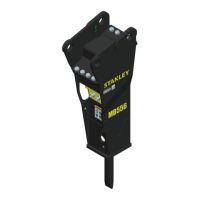22 ► MB556 User Manual
STANLEY breakers are available with several dierent
types of tool bits. The most common are the moil, chisel
and the blunt. Each of these working steels has its own
purpose as described below:
To obtain the maximum production from the breaker, it
is important to select the proper working steel. Consult
your STANLEY representative for assistance in select-
ing the proper working steel for your application.
MOIL
This is by far the most popular
working steel. It is a general
purpose point used to break
anything from concrete to
hard rock. Its pencil-type
point is used to fracture the
material. The tool is best where
penetration speed is important.
CHISEL
This style of point is used
generally used for trench work,
where a controlled break is
required, and for rock breaking
on materials with a denite line
of cleavage. A chisel bit also
works well in softer concretes
where a moil might penetrate
quickly, but not cause a fracture
line.
BLUNT
This at type of point is used to
break softer material such as
coal or shale. A moil or chisel
will tend to punch holes in this
type of material, where a at
blunt will shatter the material.
It is also useful when breaking
irregularly shaped material
where its broad tip makes it
easier to position.
The other parts of the broken surface are brittle.
This is the only kind of tool bit failure that is always
covered under warranty.
Figure 25. Internal Material Flaw
As a rule, working steel failures can be diagnosed by
looking at the break itself, and at the place on the steel
where the break occurred. Discoloration, like “rainbow”
eects or blue bands, is the result of extreme heat.
Look for surface cracks, galling, or gouge marks. Breaks
that start as surface damage have a “sea shell” pattern,
with the damaged spot at the center. A large “sea shell”
indicates a slow growing break. A small one indicates
one compounded by side stress.
Stress failures start small, and spread into the center
of the steel. In a stress failure, the coarser the grain,
the greater the stress was, and the more rapid was the
failure.
• Failures in this area are usually the result
of blank ring, worn bushing(s), worn re-
tainer pin(s) or the lack of lubrication.
• Failures in this area are usually the result
of worn retainer pin(s) or blank ring.
• Failures in this area are usually the result
of prying, metal-to-metal contact or corro-
sion. Prying failures often exhibit a shell-
like formation near the edge of the steel
diameter where the break began, and a
“tail” opposite that where the remaining
steel bent and tore.
• Failures in this area are usually the result
of heat build-up, mushrooming, or improp-
er contact with the work.
Figure 26. Diagram of Tool Bit Failures
PROPER USE & CARE OF TOOL BITS

